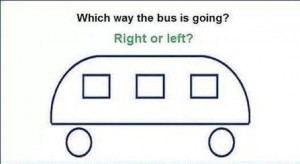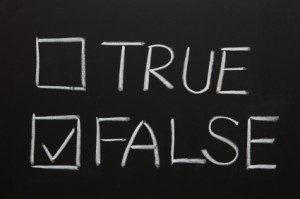Now You See It, But You Don’t

What don’t you see?
The problem with seeing is that you only see what you see. We may see something and try to make reasonable deductions from it. We assume that what we see is all there is. All too often, the assumption is completely erroneous. We wind up making decisions based on partial evidence. Our conclusions are wrong and, very often, consistently biased. We make the same mistake in the same way consistently over time.
As Daniel Kahneman has taught us: what you see isn’t all there is. We’ve seen one of his examples in the story of Steve. Kahneman present this description:
Steve is very shy and withdrawn, invariably helpful but with little interest in people or in the world of reality. A meek and tidy soul, he has a need for order and structure, and a passion for detail.
Kahneman then asks if it’s more likely that Steve is a farmer or a librarian?
If you read only what’s presented to you, you’ll most likely guess wrong. Kahneman wrote the description to fit our stereotype of a male librarian. But male farmers outnumber male librarians by a ratio of about 20:1. Statistically, it’s much more likely that Steve is a farmer. If you knew the base rate, you would guess Steve is a farmer.
We saw a similar example with World War II bombers. Allied bombers returned to base bearing any number of bullet holes. To determine where to place protective armor, analysts mapped out the bullet holes. The key question: which sections of the bomber were most likely to be struck? Those are probably good places to put the armor.
But the analysts only saw planes that survived. They didn’t see the planes that didn’t make it home. If they made their decision based only on the planes they saw, they would place the armor in spots where non-lethal hits occurred. Fortunately, they realized that certain spots were under-represented in their bullet hole inventory – spots around the engines. Bombers that were hit in the engines often didn’t make it home and, thus, weren’t available to see. By understanding what they didn’t see, analysts made the right choices.
I like both of these examples but they’re somewhat abstract and removed from our day-to-day experience. So, how about a quick test of our abilities? In the illustration above, which way is the bus going?
Study the image for a while. I’ll post the answer soon.
Two Brains. So What?

Alas, poor System 1…
We have two different thinking systems in our brain, often called System 1 and System 2. System 1 is fast and automatic and makes up to 95% of our decisions. System 2 is a slow energy hog that allows us to think through issues consciously. When we think of thinking, we’re thinking of System 2.
You might ask: Why would this matter to anyone other than neuroscientists? It’s interesting to know but does it have any practical impact? Well, here are some things that we might want to change based on the dual-brain idea.
Economic theory – our classic economic theories depend on the notion of rational people making rational decisions. As Daniel Kahneman points out, that’s not the way the world works. For instance, our loss aversion bias pushes us towards non-rational investment decisions. (See also here). It happens all the time and has created a whole new school of thought called behavioral economics (and a Nobel prize for Kahneman).
Intelligence testing – System 1 makes up to 95% of our decisions but our classic IQ tests focus exclusively on System 2. That doesn’t make sense. We need new tests that incorporate rationality as well as intelligence.
Advertising – we often measure the effectiveness of advertising through awareness tests. Yet System 1 operates below the threshold of awareness. We can know things without knowing that we know them. As Peter Steidl points out, if we make 95% of our decisions in System 1, doesn’t it also follow that we make (roughly) 95% of our purchase decisions in System 1? Branding should focus on our habits and memory rather than our awareness.
Habits (both good and bad) – we know that we shouldn’t procrastinate (or smoke or eat too much, etc.). We know that in System 2, our conscious self. But System 2 doesn’t control our habits; System 1 does. In fact, John Arden calls System 1 the habitual brain. If we want to change our bad habits (or reinforce our goods ones), we need to change the habits and rules stored in System 1. How do we do that? Largely by changing our memories.
Judgment, probability, and public policy – As Daniel Kahneman points out, humans are naturally good at grammar but awful at statistics. We create our mental models in System 1, not System 2. How frequently does something happen? We estimate probability based on how easy it is to retrieve memories. What kinds of memories are easy to retrieve? Any memory that’s especially vivid or scary. Thus, we overestimate the probability of violent crime and underestimate the probability of good deeds. We make policy decisions and public investments based on erroneous – but deeply held – predictions.
Less logic, louder voice – people who aren’t very good at something tend to overestimate their skills. It’s the Dunning-Kruger effect – people don’t recognize their own ineptitude. It’s an artifact of System 1. Experts will often craft their conclusions very carefully with many caveats and warnings. Non-experts don’t know that their expertise is limited; they simply assume that they’re right. Thus, they often speak more loudly. It’s the old saying: “He’s seldom right but never in doubt”.
Teaching critical thinking – I’ve read nearly two-dozen textbooks on critical thinking. None of them give more than a passing remark or two on the essential differences between System 1 and System 2. They focus exclusively on our conscious selves: System 2. In other words, they focus on how we make five per cent of our decisions. It’s time to re-think the way we teach thinking.
Questions To Improve Decisions

What else should I consider?
One of the critical skills of critical thinking is the ability to ask insightful, illuminating questions. Indeed, questioning is an attitude as much as a skill. As information flows into our brains, we know that it needs to be checked for clarity and accuracy. We assume the same attitude that a warehouse manager might have: all incoming deliveries need to be checked.
I always keep two simple questions in mind:
Why do I/you think that?
How do I/you know that?
These help me review incoming information quickly. I can then assign the information to three large – and fairly fuzzy – categories:
Probably true
Probably not true
Unproven/can’t evaluate
The virtue of my little system is not that it’s 100% accurate but that it’s simple. I can do it in real-time and keep rough track of ideas and concepts while discussing them. It’s fuzzy and lumpy but also quite handy.
When I asked my students about their go-to questions, they came up with five categories in a stepwise process, beginning with gaining self-control and ending with fixing the process. Their system covers more bases than mine and the categories are more structured. The downside? I find it hard to remember five things simultaneously. It’s great for moments of quiet reflection and evaluation but less useful for real-time discussions.
I may have found a compromise between the two systems. Joe Y.F. Lau calls it the fourfold path to good thinking in his book, An Introduction to Critical Thinking and Creativity. The four questions in Lau’s path are straightforward:
- What does it mean? – Subquestions might include: Are the main concepts clear? Can we make it more precise? Are there examples that illustrate the concept (or its opposite)? How does this concepts relate to other concepts that I believe to be true (or untrue)?
- How many supporting reasons and objections? — Subquestions might include: How many reasons tend to support the claim? How many reasons tend to undermine the claim? Can we identify examples and counterexamples? How many of each?
- Why is this important or relevant? — Subquestions might include: What are the consequences? Is it surprising? Have I learned something new? Who is supporting (or opposing) this claim? Why are they doing so?
- Which are the other possibilities to consider? — Subquestions might include: What other information might be relevant? What other cases should we think about?
The last question seems very similar to two other sources. As Daniel Kahneman reminds us: What you see is not all there is. As the Brothers Heath remind us: the first step of the WRAP decision process is, Widen Your Options.
The output of Lau’s system becomes the input to Kahneman and Heaths’ decision-making frameworks. The beauty of Lau’s system is that it verifies and evaluates the information before it gets into the decision process. Like the warehouse manager, we ensure the quality of the input. That’s necessary (but not sufficient) to ensure the quality of the output.
The other virtue of Lau’s approach is its simplicity. I can keep four points in mind (most of the time). Perhaps we can simplify it even further by creating an acronym from it. Anyone want to try?
Facts Behaving Badly

One building or two?
A fact is a fact is a fact. Isn’t it? Well … not so fast.
Let’s think of a simple fact … like the number of rooms in a building. That seems factual, doesn’t it? It’s observable, verifiable, reliable, and objective. Multiple, independent observers should come to the same conclusion. If John says it’s X, Mary can verify his work by counting again. Further, it doesn’t change over time. Today’s answer should be the same as tomorrow’s. Additionally, it’s not subjective; it doesn’t depend on your mood. It’s objective – it exists in the real world, not just inside your head.
That’s what you may think but it’s actually a bit more complicated. I often run an experiment in my classes and workshops that shows how difficult it can be to pin down a fact.
I start by asking for three volunteers. My instructions are simple: “I want you to answer the question: how many rooms are on this floor of this building?” If they ask questions, I say, in a slightly superior voice, “This is a simple exercise. There’s no need to ask questions. Don’t make it more complicated than it is. Just go and do it.” (Did you ever have a boss that did this to you?)
Then I send the volunteers out one at a time to count the rooms. Each one is instructed to count the number of rooms, write the number on a piece of paper, give the paper to me, and tell no one else the number.
I collect the three answers and compare them for the class. The three answers are never the same. In fact, they often vary by a factor of two. One person may count 24 rooms; another counts 48. Occasionally, I’ll find that two answers are the same but, if so, the third is usually quite a bit different.
How do we account for this? Two thoughts come to mind. First, the exercise contains three different concepts that need to be defined: room, floor, and building. What is a room? Does a janitor’s closet count? A bathroom? What’s a floor in this sense? What if you’re in split-level building? And what’s a building? What if two buildings are joined together, as is the building where I teach at the University of Denver?
Second, this helps to illustrate how reality is an internal concept. Each volunteer has a model of reality in her head. But the models are different. In some sense, there is no external, verifiable reality. We just build models and your model is different from mine. The result? Endless confusion and controversy. Moral: be careful with your facts.
Thinking Under Pressure

Thinking is hard.
Thinking is hard. It’s even harder when you’re under pressure. Stress lowers your IQ. When your boss is yelling at you, and your ears are pinned back, it’s hard to remember to think rationally. It’s hard to think at all – mainly you just react.
So, I always encourage my students to keep several go-to questions in their heads. These are simple, memorable questions that are always available. You can go to them quickly in an emergency. Why would you go to them? Perhaps you want to clarify the situation. Maybe you need more information. Or maybe, just maybe, you need to buy a little time.
In class the other night, I asked my students to write down their best go-to questions. They had been thinking about critical thinking for seven weeks so I assumed that they had some pretty good questions on the tips of their tongues. I was right.
I looked over the questions and realized that they fell naturally into five categories. Here are the categories with the most frequently asked questions. You might want to carry some of them around with you.
1) Gaining Self-Control – first things first: you can’t manage a situation if you can’t manage yourself. My students focused first on assessing their own situation, with questions like these:
Am I breathing effectively?
What’s my posture like? How can I change my posture to present myself more effectively?
What am I feeling right now? Are my feelings rational?
How can I engage my thinking function?
What is the other person’s purpose? Why is he behaving this way?
2) Clarifying the facts – once you’ve calmed yourself and cleared your head, you’ll want to establish what’s actually happening, with questions like these:
What are the facts? How do we know they’re facts? How were they verified?
Where did the information come from? Was the source credible?
What are our assumptions? Are they reasonable?
How did we get from the facts to the conclusions? Were there any logical fallacies along the way?
Why is this important? How does it compare in importance to Topic X or Topic Y?
Who wants to know? What is her purpose?
3) Clarifying the other person’s position – the information you have may be accurate but you also need to make sure you understand the other person’s position regarding the information. Here are some useful questions:
What’s your take on this? How do you see this?
Why do you say that? What makes you believe that?
Can you explain it in a different way?
What does “xyz” mean to you? How do you define it?
Can you paint me a picture of what you’re seeing?
Why are you so upset?
4) Clarifying the decision – you now know the “facts” and the other person’s interpretation of the facts, but you still need to figure out what decision you’re trying to make.
What outcome do we want? What’s our goal? Why?
What outcomes are possible? Which one(s) seem most fair?
Is there more than one solution? Are we trapping ourselves in a whether-or-not decision?
What if the outcome we want is not possible? Then what will we do? Is there another outcome that we might aim for?
What’s the timeframe? Are we thinking short-term or long-term?
Who else do we need to include?
How will we know when/if we need to re-visit the decision?
5) Fixing the process – when a problem arises, most organizations aim to fix the problem. They often forget to investigate the process that created the problem. Don’t forget these questions. They may well be the most important. But don’t aim for blame; this is a good time for appreciative inquiry.
How did we get here?
How can we improve our decision-making process to avoid this in the future?
What were the root causes?
How could we make a better decision in the future?